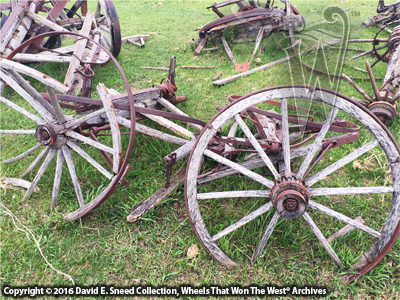Summertime is just around the corner andwith school activities wrapping up for many, there are countless vacationsbeing planned. It’s the time of yearthat reminds me of several trips we took with our kids. Even thoughwe tried to ensure that every retreat included elements for everyone, I’m stillaccused of planning those getaways in the vicinities of early vehiclecollections. Okay, I may be a littleguilty but the reality is that there are numerous examples of period wagons andcoaches scattered all over the U.S. So,our trips to Washington D.C., Mount Rushmore, Pikes Peak, Ft. Worth, Nashville,St. Louis, Kansas City, and even Disneyland always managed to have a stop ortwo to take in some wood-wheeled wonders.
One of the most rewarding parts totraveling and viewing vehicles in other parts of the country is that you cansee a lot of different features and configurations. Fact is, specific areas often had particulardesigns and ways of doing things that aren’t seen elsewhere. Once you begin to notice those details, itbecomes easier to recognize regional styles. It’s another part of the authentication process that’s crucial forcollectors.
Last week, I shared a few details aboutan original stage wagon we were conserving with the help of Doug Hansen and histeam. While I was at the South Dakota shop, I had a chance towalk through Doug’s bone yard of wheeled relics. As we passed by one piece, he mentioned thatit was an Indian wagon. It's a term you don't hear too often but, still yet, the legacy is an important part of Old West history. These wagons were sold to the U.S. Government as part of provisions madeavailable to American Indians. Whilethis particular set of wheels happened to be a Studebaker, there were many other brandsthat also built these wagons. Competition for the contracts was fierce and sometimes resulted in legalactions when a bid was lost.
I took special interest in the piece forseveral reasons. First, even thoughthere were thousands of these wagons built, they are rarely identified today. Second, these vehicles can easily date to the19th century and that construction timeframe is becoming harder to find outsideof a collection. Third, some of today’smost legendary and elusive brands were known to have built these wagons –Caldwell and Jackson being among the most difficult to come across. So, running across this kind of history in aSouth Dakota pasture was a bonus I wasn’t expecting. It’s yet another reminder that you never knowwhat you’re going to see or where. As aresult, it’s best to stay vigilant and take plenty of photos and notes. Scarce pieces can show up when least expectedand aren’t always immediately recognized. Thorough documentation can be especially beneficial years later when moreinsights are known about a particular brand or design.
I’ll share a little more about thesewagons in a later blog. My main pointhere is to encourage watchfulness when you travel. While millions of America’s earliest woodenvehicles have disappeared, many are still out there. As an example, in the past two weeks, mytravels have allowed me to see dozens of different designs – and even moreindividual pieces. Almost all of themwere a surprise to find. Some of themost logical places to run across early wagons and coaches are in museums. Even so, there are some truly amazingsurvivors in private collections. Without a little guidance, though, it can be tough to know what piecesare where. Joining organizations likethe American Chuck Wagon Association,Carriage Association of America, andthe National Stagecoach & Freight Wagon Association can be very helpful. Networking opportunities within these groups can open doors to rarepieces that are seldom seen.
Ultimately, if you have a vacation onthe horizon and time to squeeze in a stop or two focused on early vehicles, do yourhomework. Every part of the U.S. has itsown share of rare and remarkable parts of yesterday. My bet is you can weave it into your time off without any other family member knowing you planned the whole trip around thesevisits – or, at least I wish you better luck than I’ve had! Have a great week.
Please Note: As with each of our blog writings, all imagery and text is copyrighted with All Rights Reserved. The material may not be broadcast, published, rewritten, or redistributed without prior written permission from David E. Sneed, Wheels That Won The West® Archives.
Please Note: As with each of our blog writings, all imagery and text is copyrighted with All Rights Reserved. The material may not be broadcast, published, rewritten, or redistributed without prior written permission from David E. Sneed, Wheels That Won The West® Archives.
